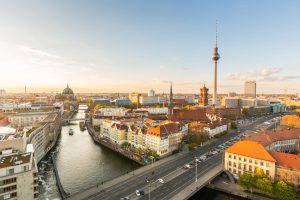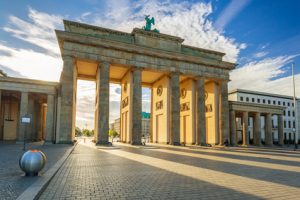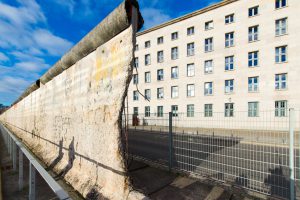Berlin: A city for every tourist
By Tracy A. Burns
 If you only have time to visit one place in Germany, go to Berlin, the largest city in the country and offers a plethora of sights and activities. There is something for everyone. Berlin can be considered a sort of Museum Heaven. Be enthralled by some of the most significant artworks in the world and learn about life in former East Germany. The Reichstag and the Brandenburg Gate are landmarks seeping with history. See what is left of the Berlin Wall at the innovative East Side Gallery and the Berlin Wall Memorial. For those interested in modern architecture, buildings will astound. Or get away from the hustle and bustle of city life: one-third of Berlin is composed of parks, forests, and gardens.
If you only have time to visit one place in Germany, go to Berlin, the largest city in the country and offers a plethora of sights and activities. There is something for everyone. Berlin can be considered a sort of Museum Heaven. Be enthralled by some of the most significant artworks in the world and learn about life in former East Germany. The Reichstag and the Brandenburg Gate are landmarks seeping with history. See what is left of the Berlin Wall at the innovative East Side Gallery and the Berlin Wall Memorial. For those interested in modern architecture, buildings will astound. Or get away from the hustle and bustle of city life: one-third of Berlin is composed of parks, forests, and gardens.
History
The capital of Germany since 1990, Berlin is no newcomer as a capital city. It served as the capital of the Margraviate of Brandenburg from 1417 to 1701; the capital of the Kingdom of Prussia from 1701 to 1918; the capital of the German Empire from 1871 to 1918; the capital of the Weimar Republic from 1919 to 1933, and the capital of the Third Reich from 1933 to 1945. Following World War II East Berlin became the capital of East Germany. Berlin was established in the 13th century. The history of Berlin is in part the history of the Hohenzollerns, who reigned as electors and later as kings until 1918. The Thirty Years’ War meant disaster for the city as half its population died and only 6,000 inhabitants remained. Mostly French Protestant Huguenot refugees flocked to the city under the 17th-century rule of Frederick William “The Great Elector,” who welcomed foreigners to his realm. Berlin flourished during the Enlightenment under the rule of Frederick II, also called “Frederick the Great” during the 18th century.
The 19th and 20th centuries
In the following century, the Industrial Revolution brought economic prosperity to the city. In 1871 Germany was unified. Many foreigners came to Berlin during the 1920s, a time period punctuated by German Expressionism, jazz, and cabaret. Berlin also made a name for itself in science, the arts, and the humanities. In 1933 a tragic era of horrors and persecution began when the Nazi Party took control. Much of the city was destroyed in air raids and the Battle of Berlin when Soviet soldiers victoriously waved their flag over the Reichstag. After the war the Western Allies of Britain, France, and the USA occupied West Berlin while the Soviets took control of East Berlin, triggering the beginning of the Cold War. In 1961 the Berlin Wall was built, and it would stand for 40 years. The Wall came down on November 9, 1989.
The Reichstag: History
The German Parliament has convened here since 1999. The building was completed in 1894, and the Imperial Diet gathered here until 1918. The structure was used again during the Weimar Republic, until 1933, when a fire destroyed most of it. Air raids did even more damage.
Taking a tour of the Reichstag
Don’t miss out on a tour of the building, which was under reconstruction from 1990 to 1999. The remarkable glass cupola, the terrace on the roof, and the Renaissance façade are all to be admired. The Soviets reached the Reichstag during the Battle of Berlin in April of 1945, and today you can read the names of Soviet soldiers in graffiti on the walls. Dine in the restaurant at the top and take in the views of the spectacular cityscape. Make your reservations well in advance at www.bundestag.de.
The Brandenburg Gate
 This 18th-century triumphal arch, Neoclassical in style, was severely damaged during World War II. The restoration took place at the beginning of this century. Imagine all the historic events that occurred here: The Soviet flag fluttered here from 1945 to 1957. In 1987 then US President Ronald Reagan uttered those fateful words: “Mr. Gorbachev, tear down this wall!” Leonard Bernstein even conducted Beethoven’s ninth symphony here in 1989.
This 18th-century triumphal arch, Neoclassical in style, was severely damaged during World War II. The restoration took place at the beginning of this century. Imagine all the historic events that occurred here: The Soviet flag fluttered here from 1945 to 1957. In 1987 then US President Ronald Reagan uttered those fateful words: “Mr. Gorbachev, tear down this wall!” Leonard Bernstein even conducted Beethoven’s ninth symphony here in 1989.
Checkpoint Charlie
While it is worth seeing the most famous crossing between former East and West Berlin, the museum, which focuses on the Western Allies in Berlin, is skippable.
The Wall
 While only a small portion of the Berlin Wall remains, it is a must to visit the East Side Gallery, where on a stretch of 1.3 kilometers, more than 100 paintings, many political in nature, have been rendered by artists from all over the world. The most well-known image shows Soviet and East German leaders Leonid Brezhnev and Erich Honecker kissing. In another rendition, a Trabant car, a widely owned automobile in East Germany, is being driven through the Wall. The Berlin Wall Memorial also includes 1.4 kilometers of an original segment of the Wall. It pays homage to the many who lost their lives trying to cross the Wall and focuses on the Wall’s role in Berlin.
While only a small portion of the Berlin Wall remains, it is a must to visit the East Side Gallery, where on a stretch of 1.3 kilometers, more than 100 paintings, many political in nature, have been rendered by artists from all over the world. The most well-known image shows Soviet and East German leaders Leonid Brezhnev and Erich Honecker kissing. In another rendition, a Trabant car, a widely owned automobile in East Germany, is being driven through the Wall. The Berlin Wall Memorial also includes 1.4 kilometers of an original segment of the Wall. It pays homage to the many who lost their lives trying to cross the Wall and focuses on the Wall’s role in Berlin.
Museum Island: The Old Museum, The New Museum
Home to five top-notch museums, this island on the Spree River was declared a UNESCO World Heritage Site in 1999. The Old Museum focuses on Greek, Etruscan and Roman antiquities. The New Museum contains Egyptian artifacts and covers the period of Pre- and Early History. Perhaps the most famous display is the bust of Egyptian Queen Nefertiti. Closed for decades after being bombed by the Allies during World War II, this museum was admitted to the public again in 2009. It has been lauded as a masterpiece of modern architecture.
The Old National Gallery, the Pergamon Museum, and the Bode Museum
The Old National Gallery features 19th-century European art, ranging from Neoclassical to Early Modern. It houses one of Germany’s largest collections of 19th-century paintings and sculptures. The Pergamon Museum shows off monumental architectural works, such as the Pergamon Altar (said to undergo restoration) and the 575 BC Ishtar Gate of Babylon. It includes collections from antiquity, the Middle East, and Islamic Art. The Bode Museum boasts Gothic sculpture as well as late Antique and Byzantine art. The coin cabinet is one of the most comprehensive, displaying coinage from 7 BC to the present.
The Gemäldegalerie, the German History Museum, and the Käthe Kollwitz Museum
The Gemäldegalerie (Old Master Paintings) boasts one of the world’s premier collections of European art from the beginning of medieval painting in the 13th century up to Neoclassicism, ending around 1800. The museum houses the best collection of German art in the world as well as outstanding Early Netherlandish and Italian paintings. Art lovers should make a point of going there. No one should skip the German History Museum, which covers German history from 1 AD to 1994, devoting many exhibits to the 20th century. Get better acquainted with German life and culture in this fascinating museum. The Käthe Kollwitz Museum features over 2,000 works, prints, drawings, posters, sculptures, and woodcuts by this remarkable German artist, who lived from 1867 to 1945.
Museums dealing with the Cold War
The Topography of Terror Museum focuses on the horrors and persecution under the Nazi regime. It is located at the former site of the Gestapo and SS headquarters. The section featuring the history of Berlin during the Third Reich is just one of its fascinating features. The former Stasi headquarters has been transformed into the quirky and creepy Stasi Museum, where the focus is on the East German political scene. Visit the office and apartment of former Minister of State Security Erich Mielke. A van once used to transfer prisoners to the nearby Stasi prison is on display, too. The prison can be visited as well. The world of Trabant cars, listening devices, and food shortages is revealed in the innovative and interactive DDR Museum, where you can see a living room from the 1970s and an interrogation room. Here you will definitely learn what it was like to live in East Germany.
The Jewish Museum and the Jewish New Synagogue
The Jewish Museum encompasses 2,000 years of German-Jewish history and is one of the largest Jewish museums in all of Europe. Learn about philosopher Moses Mendelssohn and composer Arnold Schoenberg. Contemporary art also decorates the museum. Topics addressed include German-Jewish soldiers during World War I and the Frankfurt Auschwitz Trial. The building itself is a modern architectural gem, which has the appearance of a broken Star of David. Fitted with a gold dome, the New Synagogue dazzles with its Moorish design and ornate façade. Built from 1859 to 1866, it was reduced to ruins in air raids by the Allies in 1943. Restoration work did not commence until 1988.
Palaces in Berlin
Berlin also has palaces. Hailing from the end of the 17th century, Charlottenburg Palace is Baroque in style. Its interiors range from Baroque to modern. The former property of the Hohenzollern family includes the Old Palace, which features a Porcelain Cabinet with 1,000 pieces of porcelain objects. The New Wing boasts the Rococo State Apartments of Frederick the Great. The palace has the largest collection of 18th-century French paintings outside France. On the grounds are a vast garden, a mausoleum, a Baroque orangery, and a museum of prehistoric archeology. Another palace worth visiting is the Rococo Schönhausen Palace, once the seat of the Hohenzollern clan and during the 1950s the seat of East Germany’s first Head-of-State Wilhelm Peck.
Time to return to Berlin
Even people who have already visited Berlin should put this city on their itinerary. The German capital changes appearance very quickly and continuously. It seems to have a somewhat frantic and exciting relationship with the cityscape and urban décor.
So many possibilities
This article has merely touched on a few possibilities for the sightseer in Berlin. There are many more intriguing ways to spend your time getting acquainted with the city. Why not take in the remarkable view from Berlin’s 368-meter high TV Tower? Go picnicking in Tiergarten Park or in one of the many other parks in the city. Go to a concert at Symphony Concert Hall. Explore the Gendarmenmarkt with its French and German twin churches. Savor the sweets in Fassbender and Rausch, Europe’s biggest chocolate shop. If you admire the contemporary architecture, don’t miss the Potsdamer Platz. Take a Spree River Cruise. Stop for lunch at Galeries Lafayette with its basement food court. Berlin will definitely dazzle and amaze people with all sorts of interests.




